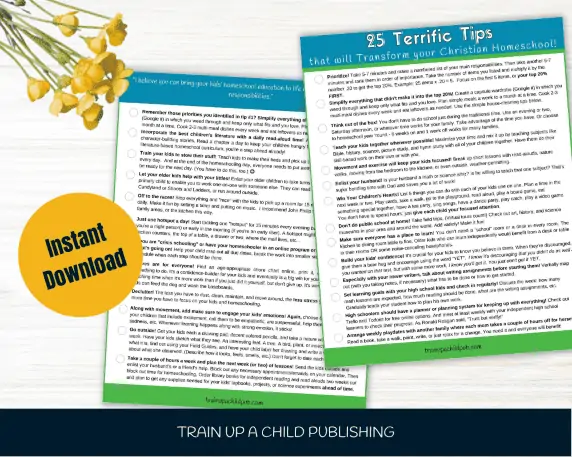Do you have a homeschooling success plan?

Many of us jump into homeschooling SCARED. TO. DEATH. You believe that it’s the best thing for your family, and then the fear sets in about whether you have the skills you’ll need and all the decisions you have to make. So you look to someone else who has homeschooled longer, and you copy everything you can from this homeschool “expert” instead of taking the time to carefully think through what’s most important to you and your family, instead of creating your own homeschooling success plan.
If you constantly compare your homeschool to your friends’, endlessly second-guess yourself, and change curriculum and activities like you do your underwear … you need a homeschooling success plan.
Without thinking through your priorities and identifying what successful homeschooling means, you’ll never feel satisfied that what you do is best for your family. You’ll be distracted by everything everyone else is doing and constantly second-guess yourself and your plans.
- Until you carefully consider what's essential for your homeschool, you'll continually chase every new idea thinking that the next one is the one that will magically make it all better.
- You need your own vision and plan for homeschooling success. Like a road map, it will keep you focused and moving in your chosen direction.
- 1. Pray.
- 2. After praying, determine your family's primary core values.
- 3. Create tactics to fit your values/goals.
- 4. Put it in Writing.
- 5. Stop "looking around" so much.
- 6. Work your plan!
- If that's you, click on the graphic below to get 25 Tips to Transform Your Christian Homeschool.
- No matter what stage of homeschooling you are in, making a Homeschool Success Plan will give you a roadmap to follow for YOUR family and keep you from living in a state of constant change and decision fatigue.
Until you carefully consider what’s essential for your homeschool, you’ll continually chase every new idea thinking that the next one is the one that will magically make it all better.
If you don’t have a well-thought-out-and-prayed-over homeschooling success plan, you might be like the “double-minded,” “unstable man” in James 1 who is “like a wave driven and tossed by the wind.”
I have felt that way. Maybe you have, too.
Maybe you feel like that now.
You need your own vision and plan for homeschooling success. Like a road map, it will keep you focused and moving in your chosen direction.
Otherwise, you will continually be distracted by the next bright, shiny program or activity that you see. You will be constantly pulled off your course.
When you homeschool with a plan, you know when to say “yes” and when to say “no.” At the beginning of each year, you decide what you and your family will do and not do, what kind of curriculum you will use for the year, how many outside activities are possible, and which ones support your goals.
So let’s make a plan!
Let’s live in peace, not trying to “live up” to what others are doing. Instead, let’s make a plan that fits YOUR family.
Let’s scrape you off the road and get you back in the driver’s seat. 😉
Creating Your Homeschooling Success Plan
Start by getting away from everything with your spouse, or if you are a single mom/dad, by yourself, or with another homeschooling parent. Take at least half a day or an evening to talk and pray about what YOU want your homeschool to be like.
1. Pray.
Read through Scripture, perhaps beginning with the verses below. Ask God to give you wisdom about your homeschooling years and show you His priorities. You’re honoring Him with your commitment to homeschool your children and raise them in the admonition of the Lord, so He WANTS to help you do it!
If any of you lacks wisdom,let him ask God, who gives generously to all without reproach, and it will be given him. (James 1:5)
Do not be conformed to this world, but be transformed by the renewal of your mind, that by testing you may discern what is the will of God, what is good and acceptable and perfect. (Rom. 12:2)
Let us not become weary in doing good, for at the proper time we will reap a harvest if we do not give up. (Gal. 6:9).
…for God gave us a spirit not of fear but of power and love and self-control. (2 Tim. 1:7)
All your children shall be taught by the LORD, and great shall be the peace of your children. (Is. 54:13)
Pray. Write down any insights you glean from prayer.
2. After praying, determine your family’s primary core values.
Considering your prayer insights, answer the following questions and brainstorm to help determine the core values you want to demonstrate in your family:
Continue to dialogue about what’s most important to you, writing everything down that you come up with. From the answers to these questions and the others you develop, create at least 5-10 primary core values for your family. These describe “what” you want your family to be.
Example:
3. Create tactics to fit your values/goals.
Tactics are the “how” you put into place to create the “what” you want your family to be. Using the first example above, these are some possible tactics:
Core Value: We will have a harmonious, peaceful household.
Tactics:
Note: These might not be priorities for your family, and that’s fine. Create values (goals) and tactics that work for YOUR family. That’s the point.
4. Put it in Writing.
Create a written homeschooling success plan by making a statement about why you are home-educating. Follow that with your family’s core values and with the tactics you’ve developed to support those values.
Once you’ve done that, you may use your plan as a guideline when making decisions about curriculum, activities, habit training, and more. You might even post your list of core values in your homeschooling area to reinforce these values with your children!
5. Stop “looking around” so much.
Okay, you’ve developed your primary homeschooling goals and tactics, written your plan, and implemented it at home. Everything is humming along just fine, and then you read about an intriguing new homeschool methodology online, find all kinds of exciting home education options on Instagram, and talk to a friend who is raving about this new program.
Commit to using the curriculum you bought for one semester, if possible. If you have problems, check with the curriculum’s publisher. The publisher may be able to give you hints for using the curriculum more effectively or point you to blog posts or articles that could help.
6. Work your plan!
Concentrate on doing what you have already decided to do well and master that before you think about adding more.
Don’t ditch what you have worked so hard on in favor of something “new.” Work your plan!
Helpful hints to stay proactive instead of reactive:
If you are experiencing problems in your homeschooling, try and figure out what the problem is:
Seeking an opinion from an experienced homeschool mom and/or a professional might be profitable if you can’t determine the issue yourself.
Have you ever taken the time to think through your family’s core values and create specific tactics to reach your goals? How might creating a homeschooling success plan help you be consistent and more secure in how you homeschool and parent?
And would you benefit from other tips that would help you bring your children’s home education to life? That would help you:
- Build a strong homeschool foundation
- Learn how to teach in concert with how children’s brains learn (according to science).
- Show you simple steps to have a happy, thriving home.
If that’s you, click on the graphic below to get 25 Tips to Transform Your Christian Homeschool.
No matter what stage of homeschooling you are in, making a Homeschool Success Plan will give you a roadmap to follow for YOUR family and keep you from living in a state of constant change and decision fatigue.
May God bless you as you complete your Homeschooling Success Plan!






I love this Dana. I homeschooled my 2 kids through 6th & 7th grade. Now my daughter is thinking about homeschooling her kids. I will share this with her.
Thank you, JoDitt! I appreciate you sharing my post with your daughter. 🙂
Spot on!
Thanks for the encouraging comment, Vicki! If we would take time to consider our values and goals before we started homeschooling it would make our homeschooling so much easier! Thanks for stopping by!
Just what i had wanted to begin to homeschool… this article has helped me to plan n work better… thanks
I’m so happy to hear that, Arjmand! There are lots of posts on the blog that may be helpful to you as you start out homeschooling. I wish you the best as you begin the adventure! =D Thanks for taking the time to comment!
Dana – what a practical, step by step approach! I think that taking it slowly, step by step, any homeschool family could benefit from the process and the result. Great ideas!
Thanks so much, Beth! It seems obvious that we would homeschool more easily with a plan, but most of us (myself included) just jumped in without taking the time to make one. It was a few years down the road before we really thought about making the “plan.” Thanks for stopping by!